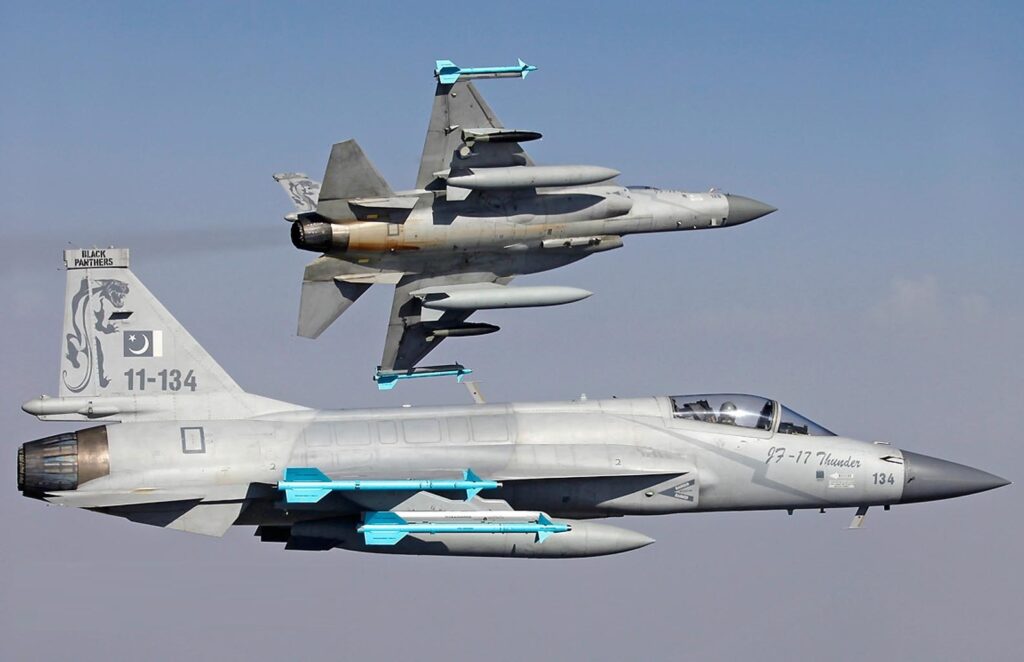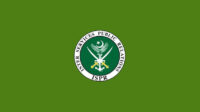By Major (R) Haroon Rasheed, Defense & Strategic Analyst – Specializing in South Asian Military Dynamics and Defense Modernization
Introduction
The JF-17 Thunder Block-III, co-developed by Pakistan Aeronautical Complex (PAC) and China’s Chengdu Aircraft Corporation (CAC), represents the most advanced phase of Pakistan’s indigenous fighter program. It is not just a low-cost alternative but a combat-proven, 4.5-generation multirole platform that combines high maneuverability, modern avionics, long-range endurance, and lethal BVR capabilities.
Sindh Government Vows Full Support for Artists
TLP Ban Enforced as Pak-Afghan Talks Continue; Cross-Border Trade Revives Amid Fresh Militancy
Pakistani fan chanting ‘Pakistan Zindabad’ after shaking hands with Shubman Gill in Adelaide
For more such Opinions & Blogs, click here.
When compared with India’s HAL Tejas Mk-1A and Sweden’s Saab Gripen E, the JF-17 Block-III stands out for its affordability, operational flexibility, and freedom from export restrictions — making it an increasingly attractive choice for cost-conscious air forces.
Design and Propulsion
The JF-17 Block-III features a redesigned airframe with reduced radar cross-section, new Digital Fly-by-Wire (DFBW) controls, infrared search and track (IRST), and an advanced KLJ-7A AESA radar. It is powered by the RD-93MA turbofan, offering increased thrust and improved fuel efficiency. Optional external and conformal tanks extend its combat radius well beyond previous blocks, enabling long-range maritime and deep-strike missions.
The Tejas Mk-1A, while agile, remains limited in payload and endurance due to its smaller frame and reliance on imported GE F404-IN20 engines. The Gripen E, though technologically superior with higher thrust and payload, comes with steep procurement and maintenance costs.
Paul Kapur sworn in as US Assistant Secretary for South and Central Asian Affairs
Durand Line History and Law Leave No Doubt — The Border Is Final and Recognized
India to cut back its imports of Russian crude
Weapon Systems and Lethality
The Block-III takes a decisive leap with integration of PL-15 BVR missiles (range: 200–240 km) and PL-10 IR missiles, giving it an air-superiority edge comparable to 4.5-generation fighters like the RafaleGripen E The AESA radar allows simultaneous tracking and engagement of multiple targets with high resistance to electronic jamming.
Unlike Western platforms bound by export controls, the JF-17’s weapon suite faces no political restrictions, allowing buyers full autonomy over munitions integration. The aircraft’s combat-proven status in real operations further enhances its credibility — something neither Tejas nor Gripen can yet claim.
Avionics and Situational Awareness
Block-III’s fully glass cockpit, wide panoramic display, helmet-mounted sighting system (HMD), and modern electronic warfare (EW) suite provide a quantum leap in pilot situational awareness. Its data link connectivity enables participation in network-centric operations, sharing real-time information with AEW&C and ground assets.
Tejas Mk-1A’s AESA and EW integration remain ongoing, while Gripen E boasts advanced fusion architecture but at a prohibitive price point for developing air forces.
Polish DPM arrives in Islamabad on two-day official visit
Pakistan urges renewed international solidarity with Syria
Pakistan taking steps against presence of Khawarij in Afghanistan: DG ISPR
Affordability and Operational Economics
With a flyaway cost of USD 30–35 million, the JF-17 Block-III offers unmatched value. Its low maintenance footprint, indigenous assembly at PAC Kamra, and readily available Chinese support ensure high sortie rates and operational independence.
By contrast, the Tejas Mk-1A costs around USD 40–45 million per unit with continued foreign dependency in propulsion and radar systems, while Gripen E exceeds USD 85 million per airwith higher life cycle and sustainment costs.
Comparative Overview — Technical & Economic Snapshot
- Feature / Specification JF-17 Block-III HAL Tejas Mk-1A Saab Gripen E
- Origin Pakistan–China Joint Development India Sweden
- Generation 4.5 Gen Multirole Fighter 4.5 Gen Light Fighter 4.5 Gen Multirole Fighter
- Engine RD-93MA (Improved RD-93) GE F404-IN20 GE F414G
- Max Thrust ~9,300 kgf ~8,300 kgf ~10,000 kgf
- Max Speed Mach 2.0 Mach 1.8 Mach 2.0
- Combat Radius ~1,500 km (with EFTs) ~1,000 km ~1,600 km
- Max Take-Off Weight (MTOW) ~13,500 kg ~13,200 kg ~16,500 kg
78th Founding Day of AJK to be celebrated on Friday
PCB announces squads for white-ball series
IED blast damages railway track in Assam, train services disrupted
- Radar KLJ-7A AESA (Chinese) EL/M-2052 AESA (Israeli/Indian) Raven ES-05 AESA (Selex)
- BVR Missile Range PL-15: 200–240 km Astra Mk-1: ~110 km Meteor: 150–180 km
- Short-Range AAM PL-10 Python-5 / ASRAAM IRIS-T
- EW & MAWS Advanced Chinese suite Indigenous upgrade Full Western suite
- Avionics Display Panoramic cockpit + HMD Glass cockpit + HMD Advanced full glass + HMD
- Combat Proven Yes Limited testing only No (non-combat tested)
- Flyaway Cost (USD) $30–35 million $40–45 million $85–90 million
- Operational Cost (per hour) ~$12,000 ~$18,000 ~$25,000
- Production Base Pakistan Aeronautical Complex (PAC) HAL India Saab Sweden
- Export Restrictions None Subject to tech origin Subject to EU/US policy
Conclusion
Each of these fighters answers a different national need.
However, the JF-17 Thunder Block-III emerges as the most balanced 4.5-generation platform — combining modern technology, long-range strike capability, and economic viability. Its indigenous assembly, PL-15 missile integration, and Pak–China partnership legacy make it a strategic asset not just for Pakistan but for any air force seeking cutting-edge capability without dependency or restrict
The JF-17 Block-III, in essence, has elevated itself from a “budget fighter” to a symbol of self-reliant aerospace power — standing tall among modern light fighters of its class.
For more such Opinions & Blogs, click here.
Kashmir tourism faces collapse under Indian occupation
No Kashmiri textbooks in schools up to Class 8 in IIOJK
Modi-led regime bulldozed 3000 homes, 27,000 people displaced in IIOJK in 6 months
Pakistan vs India T20 World Cup 2026 Clash Set for February 8 in Colombo
Major (R) Haroon Rasheed is a Defense and Strategic Analyst specializing in South Asian military dynamics, deterrence strategy, and defense modernization. He is a member of the Research and Evaluation Cell for Advancing Basic Amenities and Development (REC ABAD).
Stay tuned to Baaghi TV for more. Download our app for the latest news, updates & interesting content!






